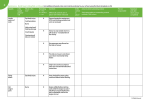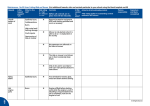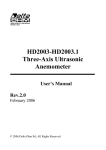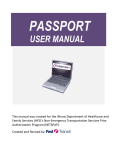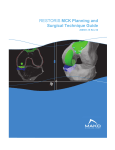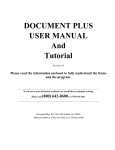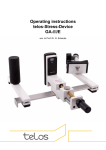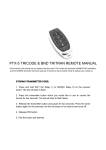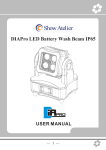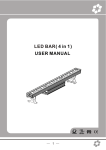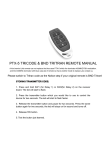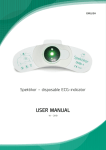Download Tri-Code
Transcript
Alabama Trauma Registry (ATR) Web Portal DI Trauma Registry – Tri-Code User Manual Tri-Code Overview ............................................................................................................. 2 Why Code with Tri-Code?.............................................................................................. 2 Using Tri-Code ................................................................................................................... 3 Editing Existing Injury Narrative.................................................................................... 4 Correcting Injury Narrative............................................................................................. 5 Abstracting Injury Descriptions.......................................................................................... 6 Coding Terminology....................................................................................................... 6 ICD9-CM: ................................................................................................................... 6 AIS (Abbreviated Injury Scale): ................................................................................. 6 ISS (Injury Severity Score):........................................................................................ 6 RTS (Revised Trauma Score): .................................................................................... 6 Injury Description Entry and Specificity: ....................................................................... 6 Spacing:....................................................................................................................... 6 Using Numbers: .......................................................................................................... 7 Use of Age in Injury Descriptions: ............................................................................. 7 Head Injuries and Loss of Consciousness (LOC):...................................................... 7 Penetrating Injuries: .................................................................................................... 8 Rib Fractures:.............................................................................................................. 8 Vertebral Fractures, Dislocations, and Cord Injuries / Disk Herniation with Nerve Root Injury/Radiculopathy: ........................................................................................ 8 Fractures with Dislocation: ......................................................................................... 9 Basilar Skull Fractures:............................................................................................... 9 Burns:.......................................................................................................................... 9 Vessel Injuries:............................................................................................................ 9 Crush Injuries:............................................................................................................. 9 Confusing Terminology:........................................................................................... 10 Descriptions with Double Meaning: ......................................................................... 10 Upgrades: .................................................................................................................. 10 Non-specific Injuries:................................................................................................ 10 Additional Injury Description Entry Guidelines:...................................................... 11 Tri-Code Assumptions:............................................................................................. 11 © 2010 Digital Innovation, Inc., All Rights Reserved 1 Alabama Trauma Registry (ATR) Web Portal DI Trauma Registry – Tri-Code User Manual Tri-Code Overview Tri-Code is based on the Abbreviated Injury Scale (AIS) injury severity coding. The injury severity score assigned by Tri-Code is dependent on the injury description abstracted and entered into the Injury Narrative. Tri-Code provides consistent injury coding. However, if injuries are not appropriately documented in patient records or are not carefully abstracted, inconsistencies will persist. This lowers the reliability and credibility of analyses using that coding. Users should obtain a copy of the most recent version of the AIS manual and review it carefully. The information in that manual is not repeated here. Why Code with Tri-Code? • • • • • • It is ranked as an expert ICD-9 and AIS coder. It allows for fast, accurate coding of injuries. It converts simple textual injury descriptions to ICD-9, AIS, and ISS scores. It provides uniform coding for trending and outcome studies. It allows for accurate comparisons of data across different datasets. It provides a statistical way to accurately measure the severity of a patient’s injuries. © 2010 Digital Innovation, Inc., All Rights Reserved 2 Alabama Trauma Registry (ATR) Web Portal DI Trauma Registry – Tri-Code User Manual Using Tri-Code Follow the steps below to use Tri-Code. 1) Enter injury descriptions into the Injury Narrative field. For specific guidelines on abstracting, refer to the Abstracting Injury Descriptions section. 2) Select the Tri-Code button. 3) The Anatomical Diagnoses information will auto-populate. © 2010 Digital Innovation, Inc., All Rights Reserved 3 Alabama Trauma Registry (ATR) Web Portal DI Trauma Registry – Tri-Code User Manual Editing Existing Injury Narrative To edit an existing Injury Narrative, follow these steps: 1) Edit the text in the Injury Narrative field. In the example below, first degree burn is added to the Injury Narrative 2) Select the Tri-Code button. 3) The Confirm Tri-Code screen will open. Select OK to confirm the changes. Select Cancel to cancel the changes. 4) The Anatomical Diagnoses information will update. © 2010 Digital Innovation, Inc., All Rights Reserved 4 Alabama Trauma Registry (ATR) Web Portal DI Trauma Registry – Tri-Code User Manual Correcting Injury Narrative The Tri-Code functionality will present users with warnings when incorrect data is entered. In the example below, stomach is spelled incorrectly. When the user selects the Tri-Code button, the Tri-Code Warnings/Errors screen will open. The warning message indicates that a substitution has been made stomach>stomach. Select the Ignore/Accept Warnings button to accept the substitution and automatically update the Injury Narrative. © 2010 Digital Innovation, Inc., All Rights Reserved 5 Alabama Trauma Registry (ATR) Web Portal DI Trauma Registry – Tri-Code User Manual Abstracting Injury Descriptions Coding Terminology ICD9-CM: • • Numerical method for tracking specific injuries 1 to 1 correspondence between injury and code AIS (Abbreviated Injury Scale): • Measures anatomical severity of injury quantitatively and objectively ISS (Injury Severity Score): • Provides a single score for measuring overall severity based on AIS codes RTS (Revised Trauma Score): • Measures physiologic severity of injury based on vital signs Injury Description Entry and Specificity: The following are general guidelines for entering the injury descriptions to Tri-Code: • • • • • • • Enter one injury description per line. Enter a complete injury description (i.e., an anatomic structure, type and extent of injury). Common abbreviations may be used. Include all details (Tri-Code cannot and will not assume information not entered). Enter all of a patient's injuries. Enter only definitive diagnoses (DO NOT include R/O (rule-out), possible or probable injuries unless you begin the line with @). Enter the side of the injury whenever possible; in many cases it will affect codes assigned. Tri-Code will process and code each injury description. When appropriate, it will upgrade severities due to the presence of other injuries. The information on the screen will identify the ICD-9-CM code, the AIS PREDOT code and severity score for each injury as well as those associated with upgrades. Further data entry guidelines are provided in the following sections. Spacing: Spacing is very important to Tri-Code. • When using numbers and words together, e.g., 2 cm, always separate the number and word with at least one space. Some other examples of this are 150 cc or 6 X 3 (dimensions). • The exception to this rule is the entry of multiple injuries. For example, if three scalp lacerations occurred, it would be entered "scalp lacs X3." This helps TriCode distinguish between 6 X 3 (by 3) and X3 (times 3). • When stating percent, use number and % sign with no space between (e.g., 15%). © 2010 Digital Innovation, Inc., All Rights Reserved 6 Alabama Trauma Registry (ATR) Web Portal DI Trauma Registry – Tri-Code User Manual Using Numbers: • • • • • • • Numbers (numerals) should be entered rather than the word equivalent when describing degree of injury. For example:2 X 3 cm lac scalp Centimeters (cm) or inches (in) only may be used to describe length and depth. Centimeters (cm2) or inches (in2) squared should be used to describe area. Cubic centimeters (cc) should be used to describe volume. Only one description using numbers should be entered per line. For example, 1 cm lac of heart w/ 250 cc hemopericardium should be entered as follows: 1 cm lac of heart 250 cc hemopericardium When there is more than one of the same injury (e.g., multiple skin lacerations), describe them using the following format: scalp lacs X2 multiple scalp lacs If length and depth detail are not available, again use numbers or "multiple" to describe more than one injury. For example: perforation of the jejunum X3 Use of Age in Injury Descriptions: • • • • AIS scores for certain injury descriptions will change depending on patient age. For these injuries, enter the patient's age on the first line. Enter the age using numbers and include years or months in the description. Age may be included on the same line as the injury text only if no other numbers are used on that line. Head Injuries and Loss of Consciousness (LOC): • • • • • Each type of head injury must be entered on a separate line even though certain injuries are combined for ICD-9-CM coding. For all head injured patients, LOC duration should be included if known. If LOC duration is not available, indicate the patient's level of consciousness on admission. If the patient is awake or lethargic on admission, indicate "prior" LOC on the same line with the level of consciousness on admission. Enter unknown or unspecified LOC if appropriate. If loss of consciousness is the only indicator of head injury, terminology such as CHI (meaning closed head injury), traumatic brain injury (TBI), head injury or cranial trauma must be entered in order for Tri-Code to code the LOC duration. This is necessary as LOC information is coded only in the presence of head injury. Tri-Code needs this information to distinguish from LOC caused by other factors (shock, drug use, etc.). All loss of consciousness information should be entered on one line. Include loss of consciousness information for deaths if duration is greater than 24 hours. © 2010 Digital Innovation, Inc., All Rights Reserved 7 Alabama Trauma Registry (ATR) Web Portal DI Trauma Registry – Tri-Code User Manual Penetrating Injuries: • • • If a patient sustains both blunt and penetrating injuries, enter all blunt injuries, then all penetrating injuries. Indicate the cause in the first penetrating injury description. Tri-Code assumes that all injury descriptions that follow it are open unless specified otherwise. For example: GSW to abdomen lac stomach fx femur In this case, Tri-Code assumes the GSW to be the cause of all subsequent injuries and codes the stomach lac and femur fx as open. If the fx femur did not result from the GSW and is not an open fracture, it must be either identified as closed or entered before the GSW entry for Tri-Code to process it correctly. Tri-Code will combine entrance wounds with underlying injuries. Exit wounds should not be entered. If entered, Tri-Code will not code them. Enter GSW or SW only once with the entrance wound. Do not enter it on every line of text. Rib Fractures: • • • • Enter the side and number of ribs fractured. Use separate lines for right rib fractures and for left rib fractures. The numbers of the fractured ribs may be entered in parentheses. This specificity is required for Tri-Code to assign the appropriate AIS severity score. If a flail chest is present, record the side(s) involved. The specific ribs fractured do not need to be identified and will not be coded in the presence of a flail chest. Correct ways to enter rib fractures are: fx L rib (assumes 1) OR fx 1 L rib (L for left) fx 3 L ribs OR fx L ribs (3,4,5) fx 2 R ribs OR fx R ribs (6,7) Vertebral Fractures, Dislocations, and Cord Injuries / Disk Herniation with Nerve Root Injury/Radiculopathy: • Numbers indicating the level of vertebral fractures, dislocations or spinal cord injuries should be entered immediately following the letter indicating the level. Enter all corresponding numbers on one line. For example: c3-5 fracture t4-5 dislocation • Spinal fractures and/or dislocation/subluxation with cord injury must be described on a single line. For example: © 2010 Digital Innovation, Inc., All Rights Reserved 8 Alabama Trauma Registry (ATR) Web Portal DI Trauma Registry – Tri-Code User Manual c4 body fx with central cord syndrome DL T9 with brown sequard syndrome • Disk herniation with nerve root injury (radiculopathy) must be stated on a single line. Fractures with Dislocation: • • Fractures of all bones with dislocation or displacement must be entered on the same line in order to be processed correctly. Each bone must be listed separately. Basilar Skull Fractures: • Clinical signs of basilar skull fractures (e.g., hemotympanum or CSF) must be stated on the same line as the fracture. For example: temporal skull fx w/ hemotympanum Burns: Burns may be coded many ways using ICD-9-CM. However, for Tri-Code, one option was chosen which is consistent with the manner in which AIS scores are assigned. • Enter the percent of body area burned for each degree of burn. • Spell out the degree of burn (first, second or third) and use numbers for the percent of body area burned, with no space between number and % sign (e.g., 10%). • Enter each degree of burn on a separate line. • See the diagram of nines in the AIS manual to determine percentage of body area burned. If the percentage of burn is not included, Tri-Code will assume NFS (not further specified). • Indicate if burns occur on the face, hand(s) or genitals. • Indicate patient age if less than one year. • Example: 10% first degree burn 20% second degree burn of arms, hands and legs Vessel Injuries: • • Describe vessel injuries as completely as possible. When indicating blood loss use % volume entered on same line as vessel injury. Crush Injuries: • • "Crushed chest" and "crushed skull", by AAAM definition, are injury descriptions that usually occur in non-survivors. If the patient's injuries do not coincide with the definitions of "crushed chest" or "crushed skull", enter more specific anatomic injury descriptions. © 2010 Digital Innovation, Inc., All Rights Reserved 9 Alabama Trauma Registry (ATR) Web Portal DI Trauma Registry – Tri-Code User Manual Confusing Terminology: • • The use of certain words may result in incorrect coding by Tri-Code. "Above" and "below" or the entry of two or more body locations in describing one injury should be avoided. For example, "lac above r eye" should be entered as "lac r eyelid" or "lac r eyebrow" or "lac r forehead" to indicate the specific location. If entered as "lac above r eye", Tri-Code will code it as a lacerated right eye, which would probably not be what the user intended. Similarly, "lac below lip" would be coded by Tri-Code as a lacerated lip when lacerated chin may be what the user actually meant. "SW RUQ below costal margin" uses the term "below" and indicates RUQ as well as the costal margin. For Tri-Code to code this correctly, be concise and enter "SW RUQ." Descriptions with Double Meaning: • • • • • • Certain injuries have different meanings when entered in different ways. Right parietal contusion can imply a contusion to the scalp or to the cerebrum. When cerebrum is not entered Tri-Code assumes the injury is to the scalp. Phalanx injuries must state finger or toe. Ventricle injuries must state head/brain or chest/heart. Septal injuries must state location. Upgrades: In the presence of other injuries and conditions, ICD-9-CM and AIS PREDOT codes may change and the AIS severity scores for some injuries may be increased or decreased. For example, fx 5 left ribs tension pneumothorax LUL, LML lung laceration In this case, the severity of the pneumothorax is included in the severity score for the lung lacerations. Therefore, the severity assigned to the pneumothorax is 0 and no upgrade is given to the rib fractures. Tri-Code processes all injury descriptions and performs the appropriate upgrade. Non-specific Injuries: The following are examples of non-specific injury descriptions that Tri-Code cannot process: • multiple fractures • dislocated joint • multiple trauma • lacerations with bleeding vessels In order for Tri-Code to process these descriptions, the sites of the fractures and dislocations must be identified and the specific injuries resulting from the trauma must be stated. The location of the lacerations and the names of the vessels must also be given. © 2010 Digital Innovation, Inc., All Rights Reserved 10 Alabama Trauma Registry (ATR) Web Portal DI Trauma Registry – Tri-Code User Manual Additional Injury Description Entry Guidelines: The following injuries must be entered on the same line in order to process them correctly: • Vertebral fx or fx/DL with associated cord injury • Bilateral hemo/pneumothoracies • Bilateral flail chest • Bilateral SDH or EDH • Injuries to uterus when pregnancy is involved must include trimester information on same line • Disk herniation with accompanying nerve root injury (radiculopathy) • Vessel injuries and % blood loss • Organ injuries and % blood loss The following injuries must be entered on separate lines in order for Tri-Code to process them correctly: • Right rib fractures must be entered on one line and left rib fractures must be entered on a different line. • Burns of different degrees must be entered on separate lines. Enter first degree on one line, second degree on a separate line, and third degree on another line. • Basilar skull fractures must be entered on a separate line from fractures to the vault of the skull. • Two or more nerve injuries in same extremity must be entered on separate lines. Nerve must be named for coding. • Fractures or joint injury with associated nerve injury must be stated on separate lines in order for all injuries to be coded and upgrades assigned. • Sacral or coccyx fractures with cauda equina injury must be listed on separate lines. • abdominal organ injuries with associated vessel injuries should be put on separate lines and the vessels should be named. The following injuries can be entered on the same line or on separate lines: • Head injury and LOC information • Bilateral fractures of the same bone • Bilateral lung lacerations • Multiple cerebral contusions specifying various locations • Radius/ulna fractures • Tib/fib fractures Tri-Code Assumptions: • • • • Frontal parietal, occipital or temporal contusions are assumed to be to the scalp unless lobe or cerebral is indicated. Internal carotid artery and vertebral artery injuries are assumed to be in the neck region unless intracranial is stated. Optic nerve injuries are assumed to be intracranial unless intraorbital is stated. Thoracic strain is assumed to be to the chest unless back or dorsal is indicated. © 2010 Digital Innovation, Inc., All Rights Reserved 11 Alabama Trauma Registry (ATR) Web Portal DI Trauma Registry – Tri-Code User Manual Proprietary Rights Notice The Web Portal and related materials, including but not limited to this document, and other written material provided by Digital Innovation, Inc. (collectively “Software Products”) constitute confidential and proprietary information of Digital Innovation, Inc. It is the responsibility of the user to comply with all applicable copyright laws. The Software Products are to be maintained in confidence and not to be disclosed, duplicated, or otherwise reproduced, directly or indirectly, whole or in part, or any materials relating thereto, except as specifically authorized by Digital Innovation, Inc. No portions of this manual may be reproduced, duplicated, or disclosed without the expressed written approval of Digital Innovation, Inc. Reasonable steps are to be taken to insure that no unauthorized persons have access to the Software Products and that all authorized persons having access to the Software Products refrain from any such disclosure, duplication, or reproduction except as authorized by Digital Innovation, Inc. Copyright © 1998-2010. Digital Innovation, Inc. All Rights Reserved. © 2010 Digital Innovation, Inc., All Rights Reserved 12












